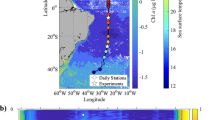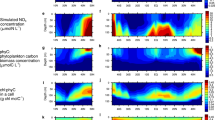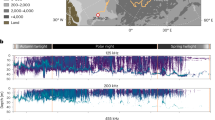Abstract
THERE is evidence that the potentially harmful solar ultraviolet-B (UV-B, 280–320 mm) radiation penetrates much deeper into the ocean's water column than previously thought1,2. UV-B radiation is also responsible for photochemical degradation of refractory macromolecules into biologically labile organic compounds3,4. It thus seems reasonable to assume that UV-B radiation might influence the cycling of organic matter in the sea, which is believed to be largely mediated by bacterioplankton5. Here we report that bacterioplankton activity in the surface layers of the oceans is suppressed by solar radiation by about 40% in the top 5 m of the water column in nearshore waters, whereas in oligotrophic open oceans suppression might be detectable to a depth of >10 m. Bacterioplankton from near-surface (0.5 m depth) waters of a highly stratified water column were as sensitive to surface UV-B radiation as subpycnocline bacteria, indicating no adaptative mechanisms against surface solar radiation in near-surface bacterioplankton consortia. Surface solar radiation levels also photochemically degrade bacterial extracellular enzymes. Thus elevated UV-B radiation due to the destruction of the stratospheric ozone layer might lead to reduced bacterial activity and accompanying increased concentration of labile dissolved organic matter in the surface layers of the ocean as bacterial uptake of this is retarded.
This is a preview of subscription content, access via your institution
Access options
Subscribe to this journal
Receive 51 print issues and online access
$199.00 per year
only $3.90 per issue
Buy this article
- Purchase on Springer Link
- Instant access to full article PDF
Prices may be subject to local taxes which are calculated during checkout
Similar content being viewed by others
References
Worrest, R. C. & Häder, D. Environ. Conserv. 16, 261–263 (1989).
Karentz, D. & Lutze, L. H. Limnol. Oceanogr. 35, 549–561 (1990).
Kieber, D. J., McDaniel, J. & Mopper, K. Nature 341, 637–639 (1989).
Mopper, K. et al. Nature 353, 60–62 (1991).
Azam, F. & Cho, B. C. Ecology of Microbiai Communities 261–281 (Cambridge Univ. Press. Cambridge, 1987).
Hoppe, H.-G. Mar. Ecol. Prog. Ser. 11, 299–308 (1983).
Marchant, H. J., Davidson, A. T. & Kelly, G. J. Mar. Biol. 109, 391–395 (1991).
Karner, M. & Herndl, G. J. Mar. Biol. 113, 341–347 (1992).
Fuhrman, J. A. & Azam, F. Mar. Biol. 66, 109–120 (1982).
Robarts, R. D. & Wicks, R. J. Limnol. Oceanogr. 34, 213–222 (1989).
Simon, M. & Azam, F. Mar. Ecol. Prog. Ser. 51, 201–213 (1989).
Hobbie, J. E., Daley, R. J. & Jasper, S. Appl. Environ. Microbiol. 33, 1225–1228 (1977).
Lee, S. & Fuhrman, J. A. Appl. Environ. Microbiol. 53, 1298–1303 (1987).
Author information
Authors and Affiliations
Rights and permissions
About this article
Cite this article
Herndl, G., Müller-Niklas, G. & Frick, J. Major role of ultraviolet-B in controlling bacterioplankton growth in the surface layer of the ocean. Nature 361, 717–719 (1993). https://doi.org/10.1038/361717a0
Received:
Accepted:
Issue Date:
DOI: https://doi.org/10.1038/361717a0
This article is cited by
-
Vertical Chlorophyll and Dimethylsulfide Profile Simulations in Southern Greenland Sea
Journal of Ocean University of China (2022)
-
Plant morphology, physiological characteristics, accumulation of secondary metabolites and antioxidant activities of Prunella vulgaris L. under UV solar exclusion
Biological Research (2019)
-
Climate change-induced increases in precipitation are reducing the potential for solar ultraviolet radiation to inactivate pathogens in surface waters
Scientific Reports (2017)
-
Physiological and genomic characterization of two novel marine thaumarchaeal strains indicates niche differentiation
The ISME Journal (2016)
-
Bacterial growth rate and the relative abundance of bacteria to heterotrophic nanoflagellates in the euphotic and disphotic layers in temperate coastal waters of Sagami Bay, Japan
Journal of Oceanography (2016)
Comments
By submitting a comment you agree to abide by our Terms and Community Guidelines. If you find something abusive or that does not comply with our terms or guidelines please flag it as inappropriate.



